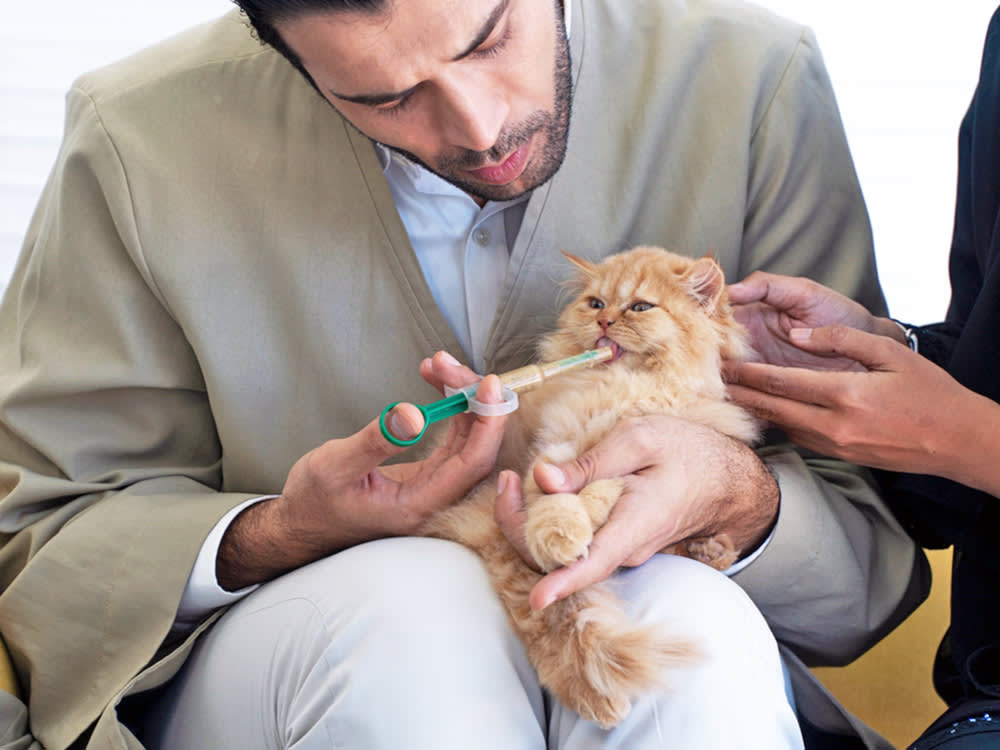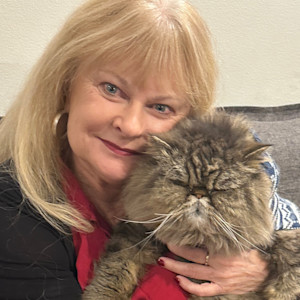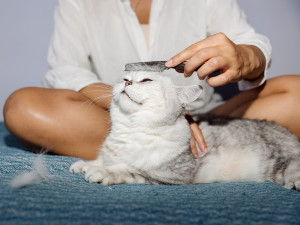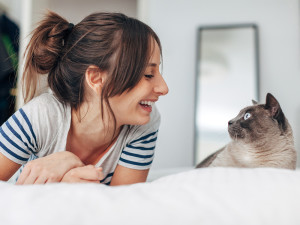The Best Way to Give Cats Liquid Medicine
We know — it’s hard. Check out our step-by-step guide.

Share Article
In This Article:
The Challenges of Giving Your Cat Liquid Medicine Preparing to Administer the Medicine Techniques for Administering Liquid Medicine Step-by-Step Guide to Giving Your Cat Liquid Medicine How to Make This as Stress-Free as Possible Troubleshooting Common Issues
Giving cats medication in any form can be challenging, but giving your cat liquid medicine is the method they usually accept best.
Cats don’t like to be restrained or have their mouth forced open, so popping a pill down their throats is often out of the question. They are master sleuths, so wrapping a pill in turkey (as you would for a dog) will also not work. They are very suspicious and have a great sense of smell, so putting liquid in their food often isn’t successful. Being picky eaters, they immediately taste a difference in their food and turn their little cat noses up.
Of all the possible ways to administer medication to a cat, you may find that liquid medication straight into their mouths is the best alternative. Even that can be tricky, so let’s review the process in detail, so you can medicate your cat when needed.
Main takeaways
Liquid medication is often the easiest way to give medicine to a cat.
But even giving them liquid meds can be challenging, and there are ways to minimize the stress of administering it.
It’s also important to create a calm set-up and environment for them during this process.

Understanding the challenges of giving your cat liquid medicine
Although liquid medicine is usually the best medication for your cat, you can still encounter some challenges administering it. A cat rarely sits there for you and opens their mouth. It requires some skill in handling your cat and getting the medicine into the mouth without causing aspiration. Read on, and you’ll learn how to give liquid medication to a cat safely. Before you know it, you’ll be a pro.
Preparing to administer the liquid medicine
Cats are quick on their feet and very good at detecting that you are about to do something to them that they don’t like. So it’s essential to prepare well in advance.
Selecting the right supplies
If you are going to give your cat liquid medication, you will need a syringe or dropper. Your veterinarian may provide one, or you can buy one at the pharmacy. Make sure this syringe or dropper has markers to help you give your cat the correct dose. You should also have a towel or blanket close by to reduce their movement, if necessary. A towel works best, but a blanket may be required for a particularly resistant cat.
Consulting with your vet
Ask your vet to show you how to administer specific medications. If they’re not available, vet techs are a great choice, too. They give medication to pets more often during the day than vets do and usually have techniques and tips that are very helpful. Always ask if the medication can be mixed with food, in case you find that going that route works best for you.
Techniques for administering liquid medicine
There are three different ways to administer liquid medication to a cat. Some work better than others. You may need to experiment to find out which one your cat tolerates the best.
Using a syringe or dropper
This is the most common method for giving cats liquid medicine. Gently place your non-dominant hand on the top of your cat’s head. Stand behind your cat, tucking its body under your non-dominant arm. Place your thumb on one side of the upper jaw and your fingers on the other. Gentle tilt the head slightly back. Insert the syringe into the side of the mouth and dispense the liquid. For more details about this method, see “Step-by-step guide to giving your cat liquid medicine,” below.
Mixing medicine with food or treats
If your cat were a dog, this method would work best. There are even treats made just for this purpose. However, as the musical Cats said it best, “A cat is not a dog.” As far as felines go, this method works best for cats who are not suspicious of changes in their treats or food, which doesn’t describe many cats.
It’s worth trying, though, because it’s easy if it works. Just be sure your cat eats the entire portion of the treat or food, so they receive the full dose. And don’t mix the medication with a whole portion of canned food. Just put the medicine in a minimal amount of food — a teaspoon or less — so you’re sure they got the entire dosage.
Using a pill gun
A pill gun adapted for liquid medicine can help with resistant cats. This tool allows for quick and precise administration, reducing stress for you and your cat. One concern with this method is the risk of aspirating liquid into the lungs when you shoot the medication into their mouths too quickly.
Step-by-step guide to giving your cat liquid medicine
Let’s go over each step involved in using a syringe or dropper to give your cat liquid medication.
Gather necessary items
Prepare all your supplies in advance. This includes the medication, syringe, a towel, and any treats or rewards you plan to give afterward. You need to have them right where you will medicate your cat, because as you know, if you take your hands off your cat, they can run away really quickly.
Secure your cat in a comfortable position
Wrap your cat in a towel or blanket to limit their movement. Hold them gently but firmly on a stable surface, such as a table or your lap. Hold your cat facing away from you and gently tucked under your non-dominant arm.
Administer the medicine
Hold the syringe or dropper containing the medication with your dominant hand. Many cats accept medication more readily if it is warmed up.
Gently grasp your cat’s head from above with your non-dominant hand by placing your thumb on one side of the upper jaw and your fingers on the other. Gently tilt the head back just a bit.
Place the tip of the syringe in the mouth, just behind one of the canine teeth (“fangs”). Advance the tip so that it sits in the slight gap between the canine tooth and the premolars behind the canine tooth.
Angle the syringe slightly to the side such that the tip deposits the medication onto the tongue. Do not forcefully inject the liquid straight into the back of the throat. Doing so can increase the risk of the cat inhaling or aspirating the liquid into its lungs.
Slowly squeeze the syringe to dispense the liquid medication. Do this slowly so the cat has time to swallow the liquid and breathe.
It is common for your cat to spit out some of the medicine. If you are convinced that they spat out all of the medication, then you can give it to them again. Otherwise, please wait until the next time it is due to give more medication. Make sure you praise your cat throughout the procedure, and offer them a special treat after giving the medication. This will make the experience more positive and make it easier to give the medicine the next time.
Rinse the syringe or dropper well after each use. If your medication needs to be kept in the refrigerator, be sure to put it back there.
Follow-up care
Comforting your cat is important following the administration of the cat medication. Gently pet and speak quietly to your cat, offering their favorite treat. Also, observe your cat closely for side effects, such as vomiting, diarrhea, lethargy, or difficulty breathing. Contact your vet immediately if you notice anything unusual.
How to make sure the administration is as stress-free as possible
When your vet prescribes medication for your pet, it is most often intended to be used daily for at least a week or more. Here are some tips to make things go as smoothly as possible.
Create a calm environment
Before you collect your cat, select an area of your home that is quiet, calm, and pleasing to your kitty. Keep other pets and people away from the area, and ask everyone in the household to maintain a low volume until you are finished. Turn off appliances such as dishwashers, washers, and dryers.
Positive reinforcement techniques
After administering the medication, offer your cat whatever pleases them the most, such as treats, praise, or playtime. This may help the process get better each time.
Troubleshooting common issues
The process of medicating your cat with liquid medication will usually go well. However, a couple of things can make the situation more difficult.
Dealing with spilled medicine
If the medicine spills on the floor or table — but only a portion of it — refill your syringe or dropper and try again. If your cat spits a lot out, do not attempt to give them more, because you do not know how much they swallowed. Wait until the next time it’s due to give them more. Do not attempt to administer another dose without consulting your vet. They can advise whether or not an additional dose is necessary.
How to handle a restless or uncooperative cat
There’s not much that can go wrong with administering liquid medication to a cat, except the cat themself. If your cat is particularly uncooperative, you can try using a helper. If your cat is really upset to the point of becoming aggressive, ask your vet if alternative forms of the medication can be prescribed. (For instance, there are liquids with flavors such as chicken and tuna.) There’s also a chance you can get the medicine as a transdermal gel, which you must rub inside your cat’s ear.
FAQs
How do you give an uncooperative cat liquid medicine?
For uncooperative cats, wrapping them securely in a towel and having an assistant hold them can make the process easier. Additionally, ask your vet about behavioral techniques or alternate medication options.
How can I make my liquid medicine taste better for my cat?
Some medications can come with flavors like chicken or fish. Speak to your veterinarian about this option, to make the medicine more palatable.
Can cats smell medicine in their food?
Yes, cats have a keen sense of smell and can often detect medication in their food. To minimize detection, mix thoroughly with strong-smelling food like tuna or chicken. Always confirm with your vet that the medication can be combined with food.
References
Carney, Hazel C, et al. “AAFP and ISFM Feline-Friendly Nursing Care Guidelines.” Journal of Feline Medicine and Surgery, vol. 14, no. 5, 17 Apr. 2012, pp. 337–349, https://doi.org/10.1177/1098612x12445002opens in new tab.
Taylor, Samantha, et al. “Online Survey of Owners’ Experiences of Medicating Their Cats at Home.” Journal of Feline Medicine and Surgery, 28 Mar. 2022, p. 1098612X2210837, https://doi.org/10.1177/1098612x221083752opens in new tab.

Dr. Shelby Neely, DVM
Dr. Shelby Neely is a freelance writer and veterinarian who graduated from the University of Pennsylvania School of Veterinary Medicine and has practiced veterinary medicine for 30 years, specializing in small animals. Her work has appeared in Allivet, AsktheCatDoctor, WhiskerDocs, Ask the Cat Doctor Radio, Ask the Cat Doctor TV, and numerous other websites, brochures, newsletters, newspapers, and ebooks. In her spare time, Dr. Neely likes to spend time with her three children, two grandchildren, three cats, two grand-cats, and five grand-dogs.
Related articles
Can Cats Actually Get the Common Cold?
They’re not exactly blowing their noses and rubbing Vicks on their chests, but here’s what you need to know.
![A woman brushes a cat's hair.]()
The Best Way to Get Rid of Fleas on Cats, According to a Veterinarian
Fleas sound like villains of a horror movie, and that’s honestly not that far off.
![Smiling Woman And Cat Looking Each Other In The Bedroom.]()
What to Know About Eye Infections in Cats
Cats’ eyes are strikingly beautiful, but goopy, irritated eyes are not.
![Tattooed and pierced woman wearing a black and white striped shirt and holding an upset looking cat]()
Is My Cat Angry at Me? How to Tell if Your Cat is Upset
Cat behaviorist Kristiina Wilson on how to tell if your cat is grumpy—or just kind of like that.




